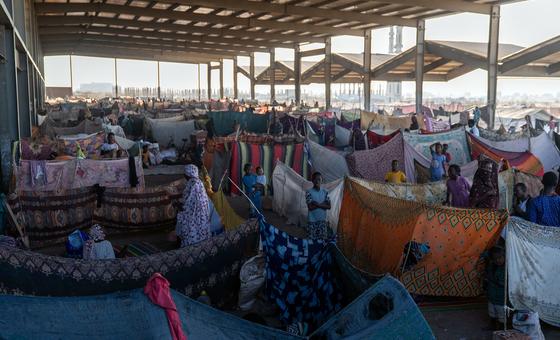
Dezeen School Shows: a redesign of the Great Pyramid of Giza is among the architecture projects from the University of Applied Arts Vienna.
Also featured is a building with a split-level scheme for social housing and a proposal that “defies the typical decline of suburban shopping centres”.
University of Applied Arts Vienna
Institution: University of Applied Arts Vienna
School: Institute of Architecture
Course: Master of Architecture
Tutors: Sam Chermayeff, Lara Lesmes, Fredrik Hellberg, Sam Jacob, Anna Gulinska, Zsuzsa Péter, Janis Stainhauser, Anousheh G Kehar, Martin Murero, Maja Ozvaldic, Bence Pap, Sophie C Grell, Eldine Heep, Sophie Luger and Giacomo Pala
School statement:
“At the IoA we make ideas about architecture. ‘Everything’, as one of our own predecessors said, ‘is architecture’. This means we make buildings, but we also make space, form, organisation, ecologies, media, environments and more. It also means we know that to make architecture means being alive to the world around us, to be open yet critically engaged.
“To reach back even further into our applied arts origins, we recognise design as a creative practice positioned between the practical and the disciplinary, between the technical and the cultural, between ‘things’ and ideas.
“Making architecture is, always and inevitably, a way of proposing alternative ideas of how we might live. Architecture as a cultural act. Architecture as a social act. Architecture as a political act.
“The things we make are both propositions and arguments. Material and labour are intertwined with politics. History is a provocation for potential futures. Theory is a way of engaging with the world. Design is a declaration of the world as it could be.
“The Institute is a platform for discourse, through things, words and images, that asks: what has architecture been? What might it become? And what could it be now?
“Through the three-year master’s degree programme – and our three design studios: Studio Sam Chermayeff, Studio Space Popular and Studio Sam Jacob – our aim is to help students develop their own positions and agency, emerging ready to apply themselves to the world.
“Student experience is enhanced by our setting within an internationally renowned applied arts university that fosters interdisciplinary collaboration, provides state-of-the-art education in artistic fields and research and promotes global exchange.”

Oscillating Grounds: A New Rhythm for Social Housing by Elias Geser, Ramita Keeratiurai and Soultana Zachariadou
“Oscillating Grounds challenges conventions in high-density social housing by radically rethinking internal spatial organisation and communal circulation.
“Through a reimagination of the split-level scheme, the building integrates vertically oscillating external corridors that continuously slope up and down on the concave side of the thin, curved volume.
“Duplex units interlock vertically and horizontally at the same time, generating openness and spatial depth – qualities rarely found in social housing.
“By combining unconventional circulation with generous, light-filled living spaces, the project establishes a distinctive architectural language that enhances both functionality and identity in high-rise social housing.”
Students: Elias Geser, Ramita Keeratiurai and Soultana Zachariadou
Course: Studio Sam Chermayeff
Tutors: Sam Chermayeff, Anna Gulinska, Zsuzsa Péter and Janis Stainhauser
Emails: elias.geser[at]student.uni-ak.ac.at, ramita.keeratiurai[at]student.uni-ak.ac.at and soultana.zachariadou[at]student.uni-ak.ac.at

59.927 metres squared – Overwhelming, Yet Digestible by Conrad Dorninger, Gün Rodoplu and Thomas Luckmann
“In our project, we explored the single-family house as a basis to design a 60,000 metres squared building – 50,000 metres squared for social housing and 10,000 metres squared for a public university campus and shops.
“Located on a plot in the outskirts of Tirana, Albania, the resulting FAR of six led us to focus on the human scale within such a dense development.
“The design operates across multiple scales, always referring back to dimensions related to the individual. At the urban scale, unit sizes and fragmentation echo the surrounding single-family homes, while their arrangement forms small public spaces.
“On the scale of the individual flat, bathing and cooking functions are pushed to the facade, imprinting the exterior and creating alcoves based on human dimensions.
“Parapets and sunshades provide privacy, while this variation in domestic function generates complexity across the facade.”
Students: Conrad Dorninger, Gün Rodoplu and Thomas Luckmann
Course: Studio Sam Chermayeff
Tutors: Sam Chermayeff, Anna Gulinska, Zsuzsa Péter and Janis Stainhauser
Emails: conrad.dorninger[at]uni-ak.ac.at, burhan-guen.rodoplu[at]student.uni-ak.ac.at and thomas-friedrich.luckmann[at]student.uni-ak.ac.at

Ghost Towers by Dario Lantschner, Magdalena Weiermann and Nick Sender
“The project consists of two towers, each divided into three sections and structured entirely on a grid. This modular framework defines everything from the facade to the spatial organisation, ensuring efficiency and clarity.
“The ground level and first floor form a vibrant public area with a transparent glass facade and dynamic layout. From the third to the tenth floor, the towers accommodate social housing, where floor plans are standardised and efficiently arranged.
“Apartments are accessed via a shared laubengang, encouraging interaction among residents. Above the structural eleventh floor, the uppermost section of each tower shifts in relation to the lower structure, creating a distinct visual break in the otherwise rigid grid.
“Here, apartments feature more adaptable layouts, made possible by a lightweight prefabricated modular system. This flexibility allows for multifunctional use, ensuring long-term viability.”
Students: Dario Lantschner, Magdalena Weiermann, Nick Sender
Course: Studio Sam Chermayeff
Tutors: Sam Chermayeff, Anna Gulinska, Zsuzsa Péter and Janis Stainhauser
Emails: dario.lantschner[at]student.uni-ak.ac.at, magdalena.weiermann[at]student.uni-ak.ac.at and nick.sender[at]student.uni-ak.ac.at

District Council Meiselmarkt by Abishek Blesson, Lorenz Andexer and Valerie Mauerhofer
“By reoccupying the disused upper floor of Meiselmarkt, once a civic reservoir and later a commercial hybrid, the project intervenes within an urban void to propose a new district council chamber – one that reframes governance as a spatial and civic experience embedded in the everyday.
“This transformation situates political discourse within the social and material flows of the 15th district, using the interior as a site of renewal through architectural and technological integration.
“A multimedia meeting space emerges through layered interactions – flexible furniture systems, digital infrastructure, and soft spatial divisions – each element designed to accommodate shifting forms of assembly.
“Rather than preserve static form, the intervention embraces the continuous adaptation of urban interiors, recognising the city as a network of evolving functions shaped from within.
“Here, civic participation is activated not through monumentality, but through spatial openness, technological presence and the reimagining of interior life.”
Students: Abishek Blesson, Lorenz Andexer and Valerie Mauerhofer
Course: Studio Space Popular
Tutors: Fredrik Hellberg, Lara Lesmes, Bence Pap, Maja Ozvaldic and Martin Murero
Emails: abhishek-blesson-manuel.alexsahayam[at]student.uni-ak.ac.at, lorenz.andexer[at]student.uni-ak.ac.at and valerie-johanna.mauerhofer[at]student.uni-ak.ac.at

Group project: Transmedia Gathering Prototype
“By drawing from traditions of the teahouse, parliamentary discourse, office furniture typologies and emergent digital platforms, this prototype explores the gathering table as a transmedia interface – one that fosters both co-presence and remote participation through spatial and technological layering.
“The design frames debate not as an abstract exercise, but as a situated and sensory practice. Interactive projections, guiding prompts and tangible objects anchor the conversation within a shared plan for the university courtyard.
“Digital integration was approached as a parallel spatial layer. Miro and Discord linked distant participants to the physical table, while a custom homepage and embedded live feed facilitated mobile interaction across platforms.
“Textile elements, inspired by ceremonial rhythm, structured the atmosphere. Curtains delineated openings and closures in the debate process.
“In its first institutional test, the prototype became a performative framework for dialogue, allowing participation to unfold across physical, digital and symbolic dimensions.”
Students: Rebekka Waters, Sara Kaurin, Abhishek Blesson Alex, Beyza Köroglu, Anna Okhrimenko, Lorenz Andexer, Katerina Suchankova and Valerie Mauerhofer
Course: Studio Space Popular
Tutors: Fredrik Hellberg, Lara Lesmes, Bence Pap, Maja Ozvaldic and Martin Murero

Hansson Centre – Challenging the White Elephant of Capitalism by Lara Schnabl, Valerie Mauerhofer and Merve Özcan
“Located within one of Vienna’s large-scale social housing complexes in the 10th district, the Hansson Centre defies the typical decline of suburban shopping centres.
“Instead, it has evolved into a lively meeting place for over 14,000 residents. Designed in the 1970s on a striking hexagonal grid, its open, glass-covered corridors blur the lines between public space and private ownership, raising urgent questions about access, control and the gradual transformation of commercial zones into pseudo-public arenas.
“This project proposes a rooftop intervention – a retractable shading system, an outdoor projection surface and modular kiosks to host seasonal events.
“Drawing inspiration from both global mall typologies and local icons like Alterlaa’s rooftop pool, the design reimagines the mall as a collective urban platform.
“At ground level, a new vertical connection has been introduced inside a clothing store. Nestled between racks of garments, a passageway leads upward – formed by movable shelving units we designed specifically for this purpose.
“Working through 1:50 scale dollhouse models, the project layers analog and digital techniques, exploring circulation, spatial nostalgia and the evolving resilience of commercial architecture.”
Students: Lara Schnabl, Valerie Mauerhofer and Merve Özcan
Course: Studio Space Popular
Tutors: Fredrik Hellberg, Lara Lesmes, Bence Pap, Maja Ozvaldic, Anousheh Gul Keharm and Martin Murero
Emails: lara-eliane.schnabl[at]student.uni-ak.ac.at, valerie-johanna.mauerhofer[at]student.uni-ak.ac.at and merve.ozcan[at]student.uni-ak.ac.at

Meiselmarkt by Liva Sadovska, Sidika Cupuroglu and Ömer Gürel
“As it is now, Meiselmarkt is experienced as a fractured building – a vibrant market below, an empty mall above and housing stacked on top.
“The intervention centres on the market’s natural rhythms. The daily expansion and contraction of stalls as they open and close, and the ongoing negotiation of boundaries that give the space its undeniable charm.
“Three key moments – the entry passage, market floor and kitchen – were studied through cameras placed at precise viewpoints to capture visual and spatial flows.
“Digital screens backdrop each scene, extending these views and blending physical and virtual layers, resulting in a truly dynamic physical model.
“These precise view – cones enabled close – up study and guided targeted cuts, additions and merges to ultimately rework the rigid borders of Meiselmarkt into a more lively and accessible space.”
Students: Liva Sadovska, Sidika Cupuroglu, Ömer Gürel
Course: Studio Space Popular
Tutors: Fredrik Hellberg, Lara Lesmes, Bence Pap, Maja Ozvaldic, Anousheh Gul Kehar and Martin Murero
Emails: liva.sadovska[at]student.uni-ak.ac.at, sidika.cupuroglu[at]uni-ak.ac.at and fethi-oemer.guerel[at]student.uni-ak.ac.at

The Centre and the Edge 1 by John Clayson, Jonas Hansen and Jonas Ramoser
“What’s the difference between the centre and the edge? How is space related to power? Are materials ideological? Can representation support democracy? How, in other words, can architecture act politically?
“This project radically removes the centre of Semper’s Neue Berg (and its infamous balcony) to connect Burggarten and Heldenplatz.
“The reconfigured urban plan forges new, multiple, axial connections to the surrounding city, inflecting toward democratic systems instead of the existing imperial alignments.
“The removed architectural elements are housed in a new conservation facility in Siebenhirten, transposing material and symbolic value from the centre to the edge of the city.”
Students: John Clayson, Jonas Hansen and Jonas Ramoser
Course: Studio Jacob
Tutors: Sam Jacob, Sophie Grell-Prix, Eldine Heep, Sophie Luger and Giacomo Pala
Emails: john.clayson[at]student.uni-ak.ac.at, jonas-samuel.ramoser[at]student.uni-ak.ac.at and jonas-immanuel.hansen[at]student.uni-ak.ac.at

The Centre and the Edge Two by Hanna Thomaseth, Morgane Wolf, Marlene Ortner and Lucia Flir
“The studio projects paired proposals that acted as urban and architectural opposites, twins or comrades. Each engaged with questions of heritage, value, use and the ways in which architecture is engaged with manufacturing/representing ideas of state, community and identity.
“While the central intervention involved the addition, extension, renovation or redevelopment of a chosen part of the Hofburg, the peripheral site accommodated a new architectural proposal, establishing a dialogue between Vienna’s historical core and its evolving boundary.
“The designers’ aim was to create two cultural sites linked through acts of making and display.
“The project on the edge rehabilitates the former brothammerwerke as a cultural and artistic exchange.
“The addition to the Hofburg building provides space for collecting, recycling and reuse. Both additions consider the value and meaning of ceramic production, connecting to the clay-rich soil of Vienna.”
Students: Hanna Thomaseth, Morgane Wolf, Marlene Ortner and Lucia Flir
Course: Studio Jacob
Tutors: Sam Jacob, Sophie Grell-Prix, Eldine Heep, Sophie Luger and Giacomo Pala
Emails: hanna.thomaseth[at]student.uni-ak.ac.at, morgane.wolf[at]student.uni-ak.ac, marlene-isabell.ortner[at]student.uni-ak.ac.at and lucia.flir[at]student.uni-ak.ac.at

The Pyramid Scheme by Jenny Roald Lyngstad
“The studio’s Pyramid Scheme brief asked: what is architecture when ‘form’ is off the table? Can such an archaic object as the Great Pyramid have contemporary relevance? How might the monumental and the singular be reimagined as collective and diverse? Can architecture engage with (or resist) totalising narratives?
“Lyngstad’s project remade the Great Pyramid with a range of different architectural references and systems, as if rewiring chronologies and histories.
“The singularity of the Great Pyramid is sliced horizontally into three distinct sections. Contemporary infrastructure at lower levels provides a new station for Vösendorf, while a stone structure above marries gothic construction with industrial warehousing.
“Above, a timber reimagining of 19th-century cast-iron frames forms the upper story. Each found constructional system is warped and stretched by the pyramid into new spatial arrangements, varying scale to suggest alternative forms of occupation.
“The project’s ambition is to synthesise diverse architectural ideas into a new kind of whole, a history of architecture within a single (giant) building.”
Student: Jenny Roald Lyngstad
Course: Studio Jacob
Tutors: Sam Jacob, Sophie Grell-Prix, Eldine Heep, Sophie Luger and Giacomo Pala
Email: jenny-roald.lyngstad[at]student.uni-ak.ac.at

The Pyramid Scheme: Soft Pyramid by Sara Gonzales
“On one hand, a very simple brief – design a pyramid exactly the same size as the Great Pyramid of Giza. But on the other, a difficult and puzzling problem – design a pyramid exactly the same size as the Great Pyramid of Giza.
“Sara Gonzales’ project remade the Great Pyramid in a manner informed by the techno-optimism of the 1970s. It stages two opposing ideas about architecture against each other: monumentality vs (apparent) modular components, absolute monarchy vs (supposed) democracy, permanence vs (claimed) reconfigurability.
“In doing so, the project resists high-tech’s rhetoric to produce a form that is simultaneously inflexible and porous. A monumental form where everything is literally laid bare.”
Student: Sara Gonzales
Course: Studio Jacob
Tutors: Sam Jacob, Sophie Grell-Prix, Eldine Heep, Sophie Luger and Giacomo Pala
Email: sara-elizabeth.gonzalez[at]student.uni-ak.ac.at

Poles, Studio Sam Chermayeff by students of summer semester 2025
“Vienna has a long tradition of multi-functional interior posts. These human-scale elements, only a few metres in size, define the space, provide comfort for various uses and enhance or frame their surroundings.
“In many great interiors, such as Hermann Czech’s Salzamt, these human-scale poles serve as coat racks, umbrella stands, lamps, newspaper holders, or all of the above.
“They are not typical items of furniture, but unusual objects that are capable of taking on diverse functions and uses.
“Building on this rich history, each of the thirty-three students of the studio received galvanised, two-metre-long steel pipes that they transformed into playful, multi-purpose objects: from paper towel holder to water fountain, fruit basket, cutting board, cranes, chairs and tables or lights.
“While they are functional objects, they don’t have an overpowering presence – a balance between nothing and something.”
Students: Students of summer semester 2025
Course: Studio Sam Chermayeff
Tutors: Sam Chermayeff, Anna Gulinska, Zsuzsa Péter and Janis Stainhauser
Partnership content
This school show is a partnership between Dezeen and University of Applied Arts Vienna. Find out more about Dezeen partnership content here.
The post Great Pyramid of Giza redesign among projects from University of Applied Arts Vienna appeared first on Dezeen.
















Leave a comment